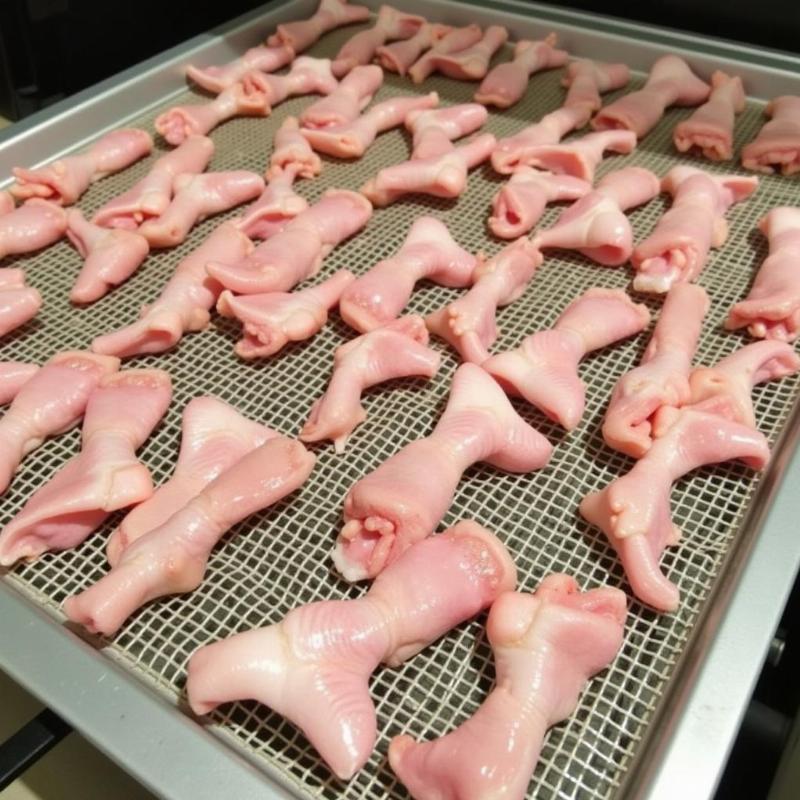Dehydrated duck feet for dogs are a popular, natural chew treat packed with nutrients and offering a satisfying gnawing experience. Making your own dehydrated duck feet ensures you control the ingredients and quality, providing a healthy alternative to commercially processed treats. This guide will walk you through the process of dehydrating duck feet at home, answering common questions and addressing important safety considerations.
Why Choose Dehydrated Duck Feet for Your Canine Companion?
Duck feet are a natural source of chondroitin and glucosamine, which are essential for maintaining healthy joints and cartilage, especially beneficial for senior dogs or those prone to joint issues. They are also a good source of protein and offer a long-lasting chew that can help satisfy a dog’s natural instinct to gnaw, reducing boredom and potentially destructive behaviors.
Choosing dehydrated duck feet over raw also eliminates the risk of bacterial contamination like salmonella, which can be present in raw poultry. The dehydration process makes them safer while preserving the nutritional benefits.
Sourcing and Preparing Duck Feet for Dehydration
You can usually find duck feet at Asian markets, some butcher shops, or through online retailers specializing in pet supplies. Look for fresh, clean duck feet with no signs of damage or discoloration.
Once you have your duck feet, thorough cleaning is crucial. Rinse them under cold running water, removing any debris or feathers. You can also soak them in a solution of water and vinegar for about 30 minutes for extra cleaning.
A Step-by-Step Guide to Dehydrating Duck Feet
- Clean the duck feet: Rinse thoroughly and optionally soak in a vinegar solution.
- Blanch (optional): Briefly blanching the duck feet in boiling water for a few minutes can help reduce the drying time and further eliminate bacteria.
- Arrange on dehydrator trays: Place the duck feet in a single layer on the dehydrator trays, ensuring they are not overlapping.
- Set the dehydrator: Dehydrate at a temperature between 160°F and 170°F (71°C – 77°C) for 6-8 hours, or until they are completely dry and brittle.
 Duck feet arranged on dehydrator trays for drying
Duck feet arranged on dehydrator trays for drying - Cool and store: Allow the dehydrated duck feet to cool completely before storing them in an airtight container in a cool, dry place.
How to Tell if Duck Feet are Properly Dehydrated
Properly dehydrated duck feet will be hard and brittle, with no moisture remaining. They should snap easily when bent. If any moisture remains, they could become moldy, so it’s essential to ensure they are thoroughly dried.
Tips for Successful Dehydration
- Even thickness: Try to select duck feet of similar size for even drying.
- Don’t overcrowd: Ensure proper airflow by arranging the feet in a single layer without overlapping.
- Monitor the process: Check the duck feet periodically and rotate trays if needed for even drying.
Safety Considerations and Potential Risks
While dehydrated duck feet offer numerous benefits, there are a few safety considerations. Always supervise your dog while they are enjoying this chew treat. Due to their brittle nature, small pieces can break off, posing a choking hazard, especially for smaller dogs or aggressive chewers.
Addressing Common Concerns about Dehydrated Duck Feet
Is it safe to give my dog dehydrated duck feet every day? While duck feet are a healthy treat, they should be given in moderation as part of a balanced diet. Too many can lead to digestive upset or weight gain.
Can puppies have dehydrated duck feet? Puppies should not be given dehydrated duck feet as their teeth are still developing and could be damaged by the hard texture.
Conclusion
Dehydrating duck feet at home is a simple and effective way to provide your dog with a nutritious, long-lasting chew treat. By following these steps and safety guidelines, you can ensure a healthy and enjoyable snack for your furry friend. Remember to always supervise your dog while they are enjoying these treats and consult with your veterinarian if you have any concerns about their suitability for your dog’s individual needs.
FAQ
- How long do dehydrated duck feet last? Properly stored, they can last for several months.
- Can I dehydrate duck feet in an oven? Yes, but it requires careful temperature control and monitoring.
- Are duck feet a good source of calcium? While they contain some calcium, they are not a primary source.
- Can I add seasonings to the duck feet before dehydrating? It’s best to avoid seasonings, as some can be harmful to dogs.
- What if my dog doesn’t like dehydrated duck feet? Not all dogs enjoy the same treats. If your dog isn’t interested, there are plenty of other healthy alternatives available.
- Can I give dehydrated duck feet to a senior dog with dental issues? Consult with your veterinarian, as the hard texture might be difficult for some senior dogs to manage.
- Are there any alternatives to duck feet for joint health? Other chews like beef tendons or trachea also provide chondroitin and glucosamine.
Beautdogs.us is your premier resource for all things dog-related in the US. We provide expert advice on dog breeds, care, and product recommendations to help you navigate the exciting world of dog ownership. Whether you’re a seasoned dog owner or just starting out, Beautdogs.us is here to support you and your furry companion. Contact us at [email protected] or call us at +1 501-555-7529 for expert guidance and personalized recommendations.